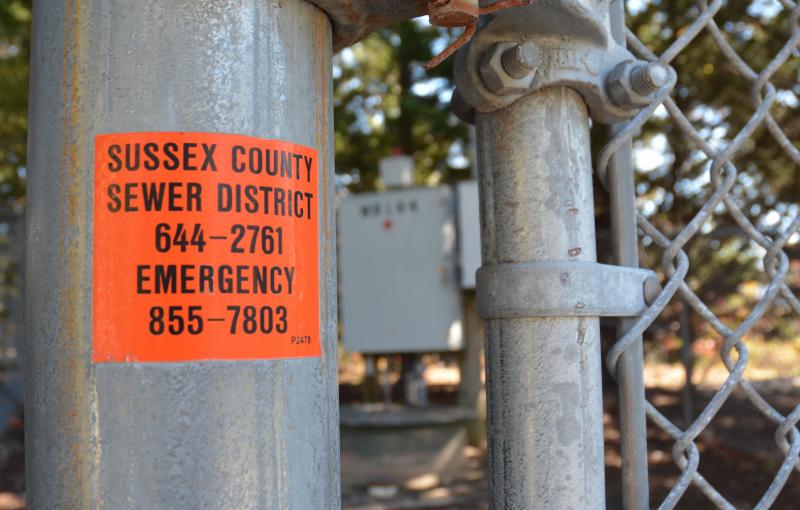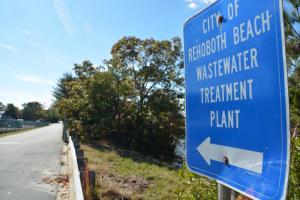County offers Rehoboth $7.6 million to tap into ocean outfall
Sussex County has offered $7.6 million to Rehoboth Beach for permission to add up to 2 million gallons of treated effluent per day to the amount currently coming from the city’s ocean outfall.
The city announced the county’s offer Oct. 27. Commissioners and members of the public got their first look at the county’s proposal during a Nov. 4 special meeting.
Public Works Director Kevin Williams said the county approached the city several weeks ago with its proposal. He said the county is offering the money as a one-time payout, and the agreement would only happen with the Delaware Department of Natural Resources and Environmental Control issuing a joint permit. The city’s current outfall permit is set to expire in June 2022.
Williams went over some other proposal details – there would be a direct connection between the outfall and the county treatment facility; the quality of effluent released by each facility would be tested at the respective city and county treatment facilities separately; and the interconnection is proposed to be bi-directional.
Aside from the monetary and infrastructure details, there are two measurements the city has to consider – the amount of effluent physically coming out of the outfall and the amount of pollutants in that effluent. Jeff Sturdevant, a representative from the city’s consultant GHD, was on hand to help explain those two considerations. In both scenarios, the city is well under maximum limitations, he said.
In relation to the outfall flow, Sturdevant said the manufacturer’s recommendation for the maximum outflow amount would be in the range of 10 million to 12 million gallons a day. However, he said, the pumps at the city’s wastewater plant only have the capacity to move 7.5 million gallons a day. The city’s plant is designed to treat about 3.5 million gallons a day, he said, which leaves about 4 million gallons a day of available capacity.
In addition to the 2 million gallons, the county’s money would also go toward covering two-fifths of the waste load allocation of the city’s permit.
Studevant said the city’s permit allows for a daily average of 425 pounds each of biological oxygen demand and solids to be coming from the outfall. Sturdevant said testing since the outfall began working in 2018 shows there are less than 50 pounds of each pollutant being pumped daily.
Sturdevant said if the county was allowed to hook into the outfall, the amount of each pollutant would be at or slightly above 50 pounds daily by 2024. By 2027, he said, the amount would still be less than 100 pounds daily.
Looking to calm fears about additional effluent polluting the swimming area of the ocean, Sturdevant said worst-case-scenario testing – the system pumping the maximum allowable flow, with the pollutants at their maximum allowable amount – has shown the ocean water returns to normal 66 feet from the diffuser at the end of the outfall.
Mayor Stan Mills said he doesn’t plan on rushing a decision, but the county has indicated it would like to have an answer by the end of the year. At Mills’ request, there were no county representatives at the meeting.
There were minimal commissioner comments on the proposal, because most of them wanted time to consider it. Mostly there were questions – why a one-time payment; pros and cons; costs to the city – that commissioners would like to have answers for by the next time they discuss the topic.
Former Planning Commissioner Harvey Shulman said allowing the county to use the city’s outfall will facilitate continued development. The county has not done good planning, and now it has a problem that the city is being asked to deal with, he said.
Planning Commissioner Michael Strange called the dollar amount woefully inadequate.
Commissioners are expected to discuss the topic again during a Monday, Nov. 8 workshop that’s scheduled to begin at 9 a.m.
Outfall history and background
While it’s been operational for a little more than three years, the ocean outfall has been an ongoing issue for the city for more than two decades.
In 1998, Delaware Department of Natural Resources and Environmental Control put into law a total maximum daily load regulation requiring the elimination of all point sources of nitrogen and phosphorus from the Lewes-Rehoboth Canal.
The city challenged the regulation, but ultimately signed a consent order in 2002 that said it would cease dumping treated effluent into the Lewes-Rehoboth Canal by Dec. 31, 2014. As that deadline neared, and after the state missed its own deadline to make a decision on whether to approve the outfall, the city was given an extension to June 2018.
In June 2015, Rehoboth voters approved a referendum to spend $52.5 million on the project, which included $25 million for the outfall pipe, $10 million for upgrades to the wastewater treatment plant, and $12.5 million for an upgraded biosolids treatment facility.
In May 2017, Delaware Department of Natural Resources and Environmental Control Secretary Shawn Garvin issued an order approving the outfall. The city had it up and running by May 2018.
The pipeline carrying the effluent begins at the city’s wastewater treatment plant and follows the canal north to Grove Park. The pipeline then turns northeast to Henlopen Avenue and makes a straight line to the Deauville Beach parking area.
The ocean outfall connects near the parking lot, and pipe runs more than 6,000 feet out into the ocean, at a depth of 40 to 50 feet below the water’s surface. The end of the pipe is a giant diffuser with tentacles that spread the water in many directions.
Chris Flood has been working for the Cape Gazette since early 2014. He currently covers Rehoboth Beach and Henlopen Acres, but has also covered Dewey Beach and the state government. He covers environmental stories, business stories and random stories on subjects he finds interesting, and he also writes a column called Choppin’ Wood that runs every other week. He’s a graduate of the University of Maine and the Landing School of Boat Building & Design.























































